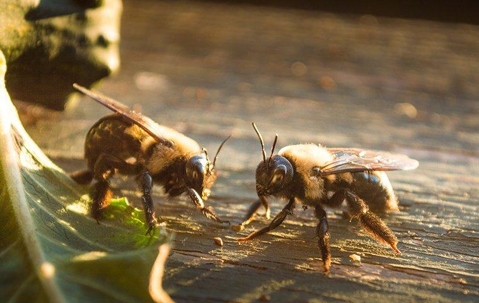For every insect, there can be several species. Most people figure that they’re all the same. This is a misconception. Each subgroup is unique, and sometimes, in multiple ways. The difference can be in eating habits, nesting patterns, and/or risks. For example, all cockroaches are capable of spreading disease. However, wood cockroaches transmit less dangerous illnesses.
When it comes to bees and wasps, the average person has a difficult time telling them apart. That said, deciphering one bee or wasp from another can be especially challenging. It’s necessary to be familiar with individual species. Then, you can properly gear up for protection and prevention with help from Quik-Kill Pest Eliminators in Peoria.
Common Peoria Bees & Risks
Honey bees are most frequent in the area. They’re around 1/2 of an inch long. They have brown or black bodies, with yellow or brown stripes. Nectar and plant pollen are their main food source. Generating honey is what they’re known for, hence their name. Their nests are made of their gland wax. If you get stung by one, it will be quite painful. Itching and redness will be localized. Allergic reactions to their venom may result in nausea, fainting, or death.
Bumble and carpenter bees also reside in Peoria:
Bumblebees: Their striped and very hairy bodies are generally ½ to one inch long. Color-wise, they’re black with yellow, orange, or red stripes. They tend to nest close to the ground in organic matter, animal burrows, and siding cracks. Only the females sting and they can do so multiple times in a brief period. Each strike increases the likelihood of an intense allergic or bodily reaction.
Carpenter bees: These max at one inch in length. Their metallic bodies can be blue, purple-blue, greenish-black, or black. Yellow markings are sometimes present. Drilling into weathered or unfinished wood is their main activity. Similar to bumblebees, just the females can give painful stings.
Common Peoria Wasps & Risks
Yellowjacket wasps are dominant in these parts. Their yellow and black bodies are 3/8 to ⅝ of an inch long. A few are white and black. Their wings are very long. Searching for bugs, nectar, meat, and sweets, these pests will swarm properties. Tree bases, patios, steps, and foundation cracks are where you’ll see their paper-looking nests. Their stings cause hurt, redness, itching, warming sensations, and allergic responses. Some people experience breathing or body system complications.
Other wasps you may see are:
Bald-faced hornets: Their black bodies cap at ¾ of an inch long, with white markings. They build aerial nests on roof eaves, poles, trees, and the like. They aggressively attack in mass and release substantial amounts of venom.
Cicada-killer wasps: They’re two or three inches long with black or red coloring, and yellow bands. They burrow and nest in sparse lawns, sidewalks, and foundations.
Mud dauber wasps: Many are ½ to one inch long, with metallic blue or black bodies. Property crevices are how they get indoors. Otherwise, their nests will be in mud.
Prevention & Quik-Kill Pest Eliminators Extermination
Bees and wasps contribute to environmental sustenance by consuming bugs and pollinating, but they can be hazardous. You can prevent them by maintaining your lawn and distancing greenery from exterior doors. Foundation holes should be sealed. Also, your garbage cans need to have tight lids.
If all else fails, contact us at Quik-Kill Pest Eliminators. Our certified technicians will apply robust and eco-friendly products to spaces impacted by these insects. Our plans are affordable and comprehensive. Afterward, we’ll check in with you to ensure all is well. Stay safe! Call us today for a free inspection!

